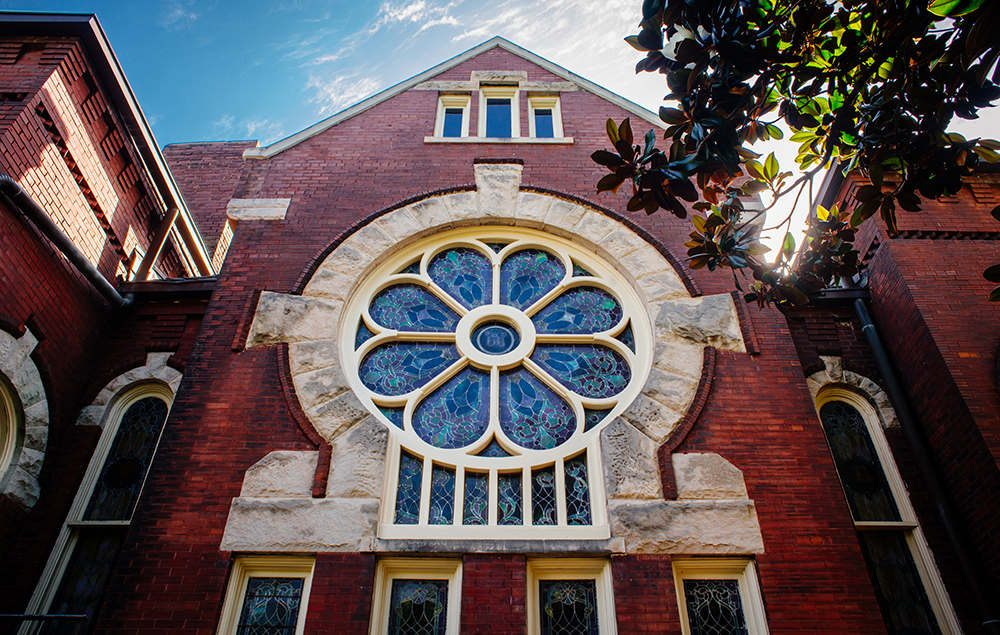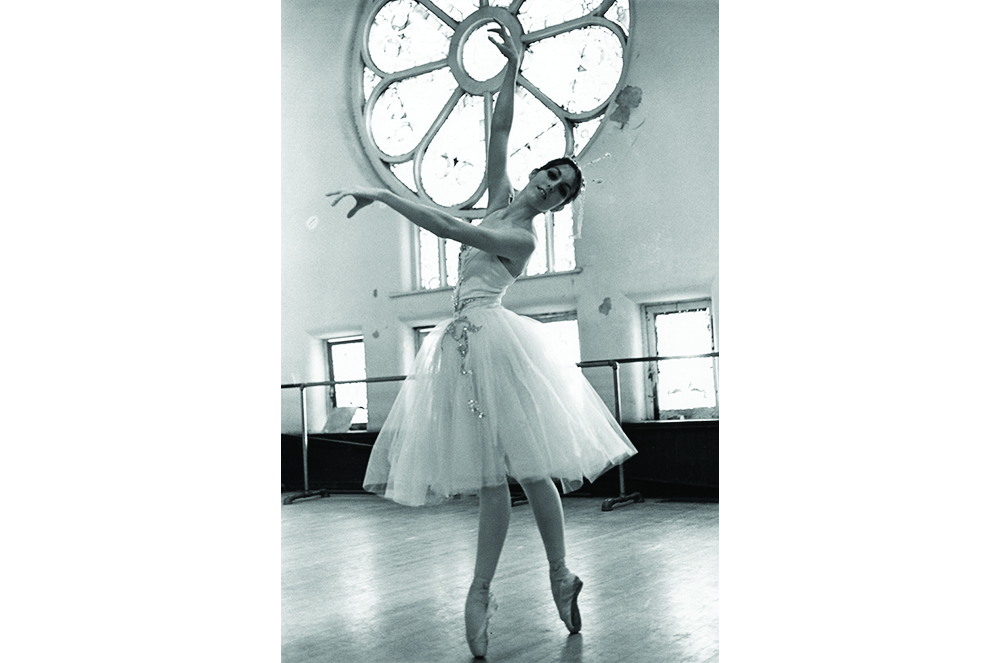 STEVE WOOD / University Relations
STEVE WOOD / University Relations
The Spencer Honors House has lived many lives — and when its signature stained glass windows were restored to their original beauty this past fall, it began a new chapter in a long story of connection and growth.
 Ada Long and honors students painted the building’s upstairs in 1987. UAB ARCHIVESThe Honors House was built in 1901 to house Southside’s Second Presbyterian Church, which occupied the building until 1963, and also was home to New Hope Baptist Church from 1964 to 1970 before becoming official UAB property. Reopened then as the UAB Ballet House, it held space for both the university’s ballet programs and the Alabama Ballet, the state's premier professional ballet company. And in the 1970s and 1980s, before the opening of the Hill Student Center’s predecessor, the Hill University Center, in 1983, the building held offices for student government and other student organizations.
Ada Long and honors students painted the building’s upstairs in 1987. UAB ARCHIVESThe Honors House was built in 1901 to house Southside’s Second Presbyterian Church, which occupied the building until 1963, and also was home to New Hope Baptist Church from 1964 to 1970 before becoming official UAB property. Reopened then as the UAB Ballet House, it held space for both the university’s ballet programs and the Alabama Ballet, the state's premier professional ballet company. And in the 1970s and 1980s, before the opening of the Hill Student Center’s predecessor, the Hill University Center, in 1983, the building held offices for student government and other student organizations.
|
“Having such a fine old building with adequate space for all our social and educational activities has helped to create a sense of identity, belonging and camaraderie.” |
The building’s life as today’s Blazers know it began in 1984, when UAB’s Honors Program moved into it. In its classroom spaces fashioned from the worship area and sacristy of the original church, honors students took courses such as “Witchcraft to Spacecraft: Man, Society and Science in the Modern World” and read books by Robinson Crusoe, Niccolò Machiavelli and Samuel Beckett. In its common spaces and former church offices, students used an early model Apple Computer for word-processing or shot pool beneath one of the building’s signature stained glass windows.
And when they weren’t learning, studying or socializing, those early honors students were working — stripping baseboards, painting and doing other general renovations, helping to restore the building to its original glory. A $150-200 investment and several hundred man-hours made by those students likely saved the university $30,000 in labor costs, estimated Ada Long, founding director of the University Honors Program — more than $77,000 today.
“Having such a fine old building with adequate space for all our social and educational activities has helped to create a sense of identity, belonging and camaraderie,” Long wrote in the program’s 1985-1986 annual report. “The students themselves have spent an enormous amount of time and energy refurbishing the house, thus making the house their own. Because of their personal investment in the house, they have made an even greater commitment to the program, both giving and gaining more.”
-
University Honors Program Founding Director Ada Long played a game of pool with two students in 1985. UAB ARCHIVES
-
The building, pictured in 1975, in its days as the UAB Ballet House. UAB ARCHIVES
-
UAB ballet student Lee Valalee posed underneath the building’s stained-glass windows. UAB ARCHIVES
-
The university invested in repairs to the exterior façade in 1988. UAB ARCHIVES
-
The Honors House’s interior, pictured in 1985. UAB ARCHIVES
Continuing the work
As time went on, more improvements were made to the building as the university invested in new technology, roof repairs, better acoustics, updated lighting and outdoor restorations — and new air conditioning, upon Long’s request.
“On hot days, students must either roast or be unable to hear the lectures,” she said in a mid-1980s story in UAB Magazine.
|
“It’s a beautiful building, and being able to take out the old windows, restore them and put them in basically brand new — they’ll be there for another hundred years.” |
The building’s most recent major overhaul came in 2001, which divided the former sanctuary into a large lecture hall, a seminar room and several small study rooms. It was dedicated in March 2002 for prominent Birmingham activist William Spencer and his wife, Virginia, who donated $2 million toward renovation costs.
Throughout the building’s many changes, watching over it all were the building’s stained-glass windows. Original to the 119-year-old building, each of the three windows is arranged in the flower-like shape of a sewing bobbin colorized with panes of predominantly red, orange, green and gold glass. The windows are one of UAB’s most recognizable features, even inspiring Vaughan Randall’s 2006 sculpture “Rosette Bobbin,” which sits in the building’s east yard.
Those windows and the building that houses them “made the [honors] program more visible on campus,” wrote Long in that mid-’80s annual report.
“It has served as an excellent recruiting device,” she continued. “It embodies the spirit of the program as a traditional, small college sitting within the larger context of an urban university.”
Terry Barnes, founder of restoration company Leeds Stained Glass, examined portions of the Spencer Honors House windows in the workshop. ANDREA MABRY / University Relations
Restoring history
Much like the rest of the Honors House, the windows couldn’t exist indefinitely without repairs, so this past fall, each window and its surrounding wood façade was restored by Leeds Stained Glass, a stained-glass studio in Pell City, Alabama. Terry Barnes, who founded the company, says restoring stained glass is a delicate, yet rewarding process.
|
“The stained-glass windows of the Spencer Honors House are a reminder of our collective history, providing a sense of continuity between the past and our present, as well as the connection between our surrounding communities and UAB.” |
“It’s a very tedious process,” he explained at the time. “We have to take all the lead off and be very careful not to break any glass.” Some of the glass is already broken, which is common in older windows, and will be replaced entirely.
“It’s an honor to be able to do it,” he said. “It’s a beautiful building, and being able to take out the old windows, restore them and put them in basically brand new — they’ll be there for another hundred years.”
Shannon Blanton, Ph.D., dean of the Honors College, says it’s important that UAB continue to maintain this piece of its history.
“For our young university, which celebrated its 50th anniversary just last year, the stained-glass windows of the Spencer Honors House are a reminder of our collective history, providing a sense of continuity between the past and our present, as well as the connection between our surrounding communities and UAB,” Blanton said.
“We are excited the university restored the windows,” she continued. “They are so beautiful, and I am glad we are carefully tending to this part of our history.”
LAURA GASQUE, CARSON YOUNG, ANDREA MABRY / University Relations




